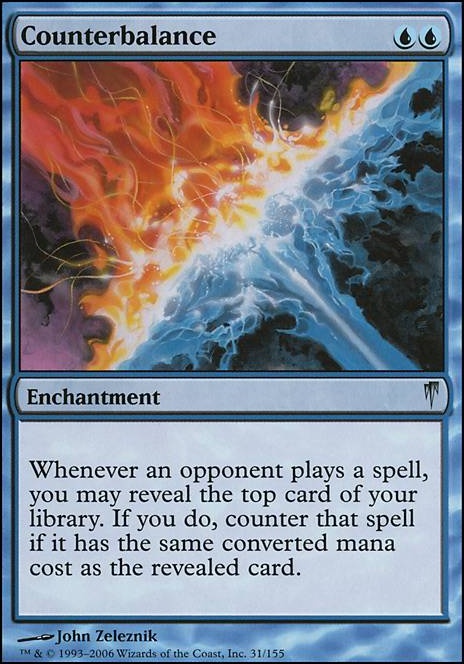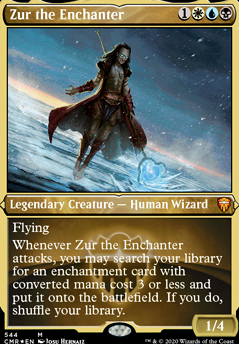The exact mix of control cards you want to run should be chosen to be most effective in your own actual metagame. Some types of decks will be overrepresented and others underrepresented; you can and should adjust the decklist to have more answers for those decks you see a lot of, and fewer for those you see less of.
Control Cards
Counterbalance
: This is super awesome with
Sensei's Divining Top
, and also pretty good with
Necropotence
, fetchlands, top-deck tutors, and randomly
Brainstorm
. But basically I now think this card is far too good to omit. Most competitive EDH decks have 35-45 spells of 1 or 2 CMC. You can randomly counter those. But besides that, it makes people slow down; nobody tries to combo through a counterbalance because it just feels so terrible to lose their spells to it. People wait until they have a bait spell to test what's on top of your library, or wait until someone else loses a spell to the counterbalance. It's basically like having a
Chalice of the Void
which resets itself to a random number in (0,1,2) every turn; and that number isn't even revealed until an opponent tests it. Pro Tip: don't flip and reveal for everything your opponents' cast, especially irrelevant bait spells. Wait for something that might matter. This kind of effect is very difficult to play around. Usually I won't fetch it with Zur unless I already have sensei's top, but it feels really efficient to cast from your hand for {u}{u} with or without the top in play.
Gilded Drake
and
Imprisoned in the Moon
(and also
Darksteel Mutation
): These are great if your opponents are playing decks that depend on the general. Stuff like Sisay, Yisan, Gitrog, Thrasios, Derevi, Azami, Arcum, Selvala, Animar, Edric, Brago, sometimes Tasigur, Zur, Jeleva, or Kess. If you're not facing many general-dependent decks (such as
Thrasios, Triton Hero
,
General Tazri
,
Teferi, Temporal Archmage
) then you can cut these.
As Foretold
: This is mostly good if your opponents are going to play some stax stuff that might really hurt us, like
Stony Silence
,
Null Rod
,
Blood Moon
, or
Back to Basics
. It's not quite good enough on its own. Bring it in against a lot of stax effects.
Chains of Mephistopheles
or
Spirit of the Labyrinth
: This is basically for
Tymna the Weaver
. A lot of decks run Tymna as one of the generals. Otherwise there's less actual card draw in the format (outside of storm) - a lot of things aren't draws (e.g.,
Ad Nauseam
,
Necropotence
). But Chains is still good if you want to mind twist everyone with a Chains +
Windfall
and then reload with
Necropotence
. Another option here is
Spirit of the Labyrinth
which can come in against a draw-focused metagame. Spirit is fetchable by Zur unless you have
Grafdigger's Cage
out already.
Spirit of the Labyrinth
is much better against
The Gitrog Monster
since it prevents draws so they can't be replaced by dredges, but it's unfortunate that these get in the way of our
Rhystic Study
and
Mystic Remora
, which are some of our best effects. However, in matchups against Tyman the weaver it's probably worth using since they're likely to get their card draw going earlier than us.
Rest in Peace
,
Leyline of the Void
,
Planar Void
,
Containment Priest
: Mostly just for graveyard stuff, if your meta doesn't have much of : Hermit Druid, Gitrog, Breakfast Hulk, Flash-Hulk, Boonweaver, Reanimator, or Breya, then you can drop Planar Void, the Leyline and the Priest (although Containment Priest is a cool surprise blocker vs. Tymna).
Grafdigger's Cage
: This is like the above, but also stops
Yawgmoth's Will
,
Protean Hulk
, Yisan, and other green direct-to-battlefield tutors (
Green Sun's Zenith
,
Chord of Calling
,
Birthing Pod
, etc), making it indispensable.
Arcane Laboratory
and
Rule of Law
: these are pretty asymmetrical since you can tutor with Zur every turn and it isn't a spell-cast. These tend to make your counterspells really awesome, as compared to something like
Sphere of Resistance
which makes counterspells harder to use. Despite the fact that these are super strong effects, it's sometimes dangerous to put them in play. The ideal situation is where you have a handful of counterspells and Zur in play. You can fetch out
Arcane Laboratory
and just try to build value by swinging with Zur every turn, until you feel safe enough to go for the win.
Arcane Laboratory
probably works best at defending the Voltron win; you just hold up your counterspells and swing with Zur to put together
Empyrial Armor
+
Necropotence
+ lifelink. Reasons to choose
Arcane Laboratory
over
Rule of Law
include the ability to pitch it to
Force of Will
and
Misdirection
, and having it be easier to cast with a mostly-blue mana base. Reasons to choose
Rule of Law
are that it can't be
Pyroblast
ed, if you cast it using a land that produces white but not blue, you're actually holding up more blue for counterspells later.
Cursed Totem
,
Linvala, Keeper of Silence
,
The Tabernacle at Pendrell Vale
,
Planar Collapse
,
Toxic Deluge
,
Porphyry Nodes
,
Supreme Verdict
,
Yahenni's Expertise
: These are the main creature-control cards; they're mostly for slowing down creature-mana elves early. The weakest are
Porphyry Nodes
and
Planar Collapse
, even though they're tutorable by Zur, they can kill Zur. Zur can survive
Planar Collapse
with
Vanishing
going on, but that is... sort of asking a lot. Similarly, you can also run
Porphyry Nodes
, which will hit Zur unless you get
Empyrial Armor
on him. But, if all your opponents play an elf,
Porphyry Nodes
will stay around forever just giving you value. I haven't tested
Yahenni's Expertise
yet, but that's also a possibility. Also
Torpor Orb
is possible if your meta includes a lot of...
Animar, Soul of Elements
or a lot of combos that are stopped by it, like
General Tazri
,
Breya, Etherium Shaper
, etc.
Winter Orb
,
Armageddon
: If you can shut off creature-based elf mana, then some land-mana hate can really shut down some kinds of decks. This can be awkward to set up a
Helm of Obedience
win with no land; however if there's a ton of other stax elements in play, Armageddon works pretty good with the Zur Voltron beatdown plan. I think these are actually better against a metagame of more stax effects. But generally I would not use them since it hurts the main counterspell plan so much.
Suppression Field
: This is a pretty insane card that shuts down a ton of stuff (fetchlands, strip mine, Yisan, Sisay, Razaketh, Gitrog discard outlets, Bomberman, Thrasios, Arcum, etc); but it also really hurts
Necropotence
. I have tried it in a more stax-focused build of Zur, but at this point I think its wrong since it does so much damage to necropotence. Could possibly bring it in against other Zur decks.
Aven Mindcensor
,
Aura of Silence
,
Grasp of Fate
,
Rhystic Study
: These cards are basically so good you'd never cut them.
Mystic Remora
is close, but you can cut it if your meta is all creature-based decks.
Cyclonic Rift
: While this is just an awesome spell, it can additionally lead to total locks. If you can end-of-turn overload the Rift, then do something like cast
Armageddon
and fetch up
Aura of Silence
and your land for turn is Tabernacle, this is a pretty hard lock.
Unsubstantiate
,
Repeal
, and
Into the Roil
: A bounce spell or two is good (in addition to
Cyclonic Rift
). So far, I've been very impressed with
Unsubstantiate
, which is great at bouncing creatures and also has utility as a counterspell.
Defending Zur
Lightning Greaves
,
Hall of the Bandit Lord
: These are good for making Zur a little harder to interact with. Haste is pretty strong. Don't worry, you can still use Zur to enchant himself if he has Shroud from the greaves. You can also bring in
Cavern of Souls
against a blue metagame with a lot of counterspells, many of the creatures in the deck are also humans (importantly,
Notion Thief
), so it can be pretty ok. However, a lot of blue decks, even those that run many counterspells, won't actually run that many unconditional counterspells that can hit a creature spell, so I haven't wanted this yet.
Swan Song
,
Stifle
,
Spell Pierce
,
Misdirection
: It's important to have a lot of extremely cheap counterspells to help protect Zur.
Stifle
can be pretty key for countering a
Fleshbag Marauder
or
Gilded Drake
.
Misdirection
is pretty good for stuff like
Abrupt Decay
, which can't target Zur obviously, but does target all the good enchantments Zur gets.
Spellskite
: this can stop some combos (like
Selvala, Heart of the Wilds
,
Leonin Relic-Warder
and
Animate Dead
, and eat
Derevi, Empyrial Tactician
triggers), or block a tymna, but mostly it'll just eat a bounce spell or
Swords to Plowshares
and let Zur live to do his thing.
Vanishing
: this card is kind of marginal and sort of mana-intensive, but it can protect Zur from anything. Can be cut if you're not expecting any midrange decks or very much creature removal or wraths. Particularly, this is one of the only answers to
Supreme Verdict
. Supreme verdict is generally rare in competitive EDH, but does show up in some kinds of control and midrange lists.
Diplomatic Immunity
: this is ok if your meta is packing a really large amount of targeted removal for Zur and other problematic commanders. Then you only have to worry about wraths, which reduces the burden on your counterspell suite. Similarly
Greater Auramancy
can work in this slot.
Proactive Cards
Necropotence
+
Empyrial Armor
+
Thought Vessel
/
Reliquary Tower
: You can frequently one-hit someone if you draw 20 cards with necropotence and don't have to discard them.
Notion Thief
+
Windfall
/
Timetwister
: this is usually a win.






